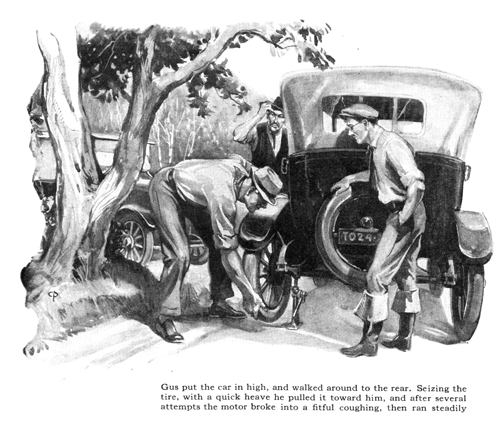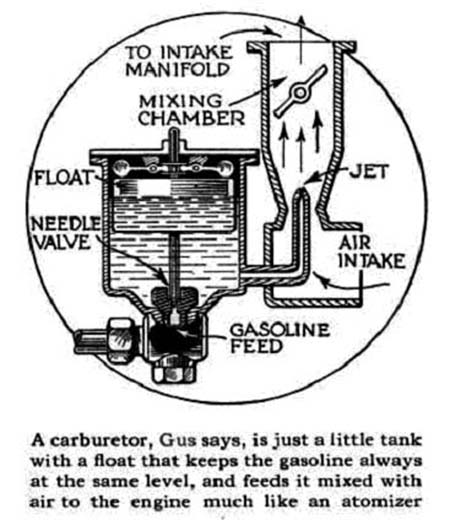April 1926
Gus Tells How to Adjust a Carburetor and Shows
HOW TO CURE STARTING TROUBLE
by Martin Bunn

"These fish will have to taste extra good to make up for my getting up so durn early, "growled Gus Wilson sleepily as he and his partner climbed into Gus's car.
"Humph!" exclaimed Joe. "You weren't so grouchy the day I went rabbit hunting with you! If you would learn how to handle a fly rod, maybe you'd be as keen on fishing as you are on hunting."
The two owners of the Model Garage had set out before dawn to get in a few hours fishing, and thanks to Joe's skill, they had a string of speckled beauties.
Gus's only answer to Joe's sarcastic remark was to kick the self-starter button and try his best to make good time over the bumpy wagon trail that led to the mountain stream.
As they were about to turn into the state highway, Gus slammed on the brakes. Stalled squarely across the trail was mud-covered, battered touring car. Nobody was in sight, but when Gus honked the horn, a tall, thin individual crawled out from under the car.
"Howdy, stranger," he saluted cheerfully. "Reckon I'm blocking the road a bit. Jest a second while I push it out of the way."
He stepped around to the back of the car, and resting one enormous, grease-smeared hand on the back panel, proceeded to lean his weight against it. It started to move at once.
"What's the trouble?" Gus inquired, for a stalled automobile was as much of a challenge to the veteran auto mechanic as a red flag is to a bull.
"Blamed if I know," replied the lanky individual. "If it was a horse, now, I could tell you, but these gasoline animals are a plum mystery to me. Least ways that goes for why it stopped -- here's why I can't get it started again," he concluded dejectedly as he held up the crank handle. He had broken it off short.
"Let's have a look at it," said Gus. He climbed out of his car and proceeded systematically to eliminate one possible trouble after another. In a few minutes he gave a grunt of satisfaction.
"Here's part of your trouble," he stated. "This fool gasoline saver has come loose and air is leaking into the manifold so fast that it spoils the mixture. Here-give me a wrench and I'll tighten it up for you. When you strike the next town I'd suggest that you throw it away and put a plug in the hole."
The owner grinned sheepishly. "Reckon that's one on me, stranger," he said.
"The garage man in the town I just passed sold me that. He claimed that it would make the gasoline last twice as long."
"Applesauce!" snorted Gus. "If all the devices that are guaranteed to double your mileage were put on one car and they did what they were supposed to do, you ought to be able to take gasoline out of the tank after each trip instead of putting it in!"
Gus tickled the carburetor until it flooded and gasoline began to drop from the bowl, in order to be sure the supply pipe was not clogged.
"Suffering cats!" he grunted. "That stuff sure smells fierce. Did you get your tank filled where they stung you for the gas saver?"
"Yes," replied the owner. "I bought five gallons there. I got a bargain, too-two cents cheaper than the last."
"Bargains nothing!" said Gus emphatically. "That's the other part of your trouble. The blamed stuff is rotten. Joe-draw off some gas from my vacuum tank and we'll get this motor started."
"But how're you going to get it started?" inquired the owner curiously. "The crank is broken."
"Got a jack?" Gus asked. "That's it. Now put it under one of the rear wheels and jack her up. Joe, you get some rocks and block the front wheels to keep it on the jack. Now watch!"
Gus put the car in high and walked around to the rear. Seizing the tire as near the ground as he could, with a quick heave he pulled the bottom of the tire toward him. After several attempts the motor broke into a fitful coughing and finally ran steadily.
"That's a good stunt to know," he said as he brushed the dirt off his hands.
"When the self-starter goes bad and you find the crank has been left at home in the garage, you can get the motor started that way.
"Now let's see what we can do with that carburetor. It sounds like the mixture is too lean, but we can't do anything to fix that until the motor is good and warm. Most people adjust the carburetor before the motor is hot, and that's one of the reasons why they get such poor mileage on gas."
"I'll be durn thankful if you'll if you'll show me how to set the carburetor, stranger," said the tall fellow in a hopeful tone of voice.
"All right," said Gus smilingly, "Come here. Look at this carburetor. See here -- this is the float chamber. It is just a little tank full of gasoline with a float in it. When the engine uses some of the gasoline, the float sinks down with the level of the gasoline and opens a valve that lets in more from the vacuum tank. That makes the float rise and shuts off the supply so the level is always the same. That's one thing you must know about the carburetor.
"The rest of the carburetor is where the gasoline is mixed with the air before it is fed into the cylinders. No two makes of carburetor look alike, but they all work on the same principle. From the float chamber there is always a small opening that leads into the air passage, and when the air rushes by it picks up the gasoline in the form of a spray just like one of these atomizers you use on your throat.
"Now there is a certain amount of gasoline in proportion to the quantity of air that gives the best kind of an explosion in the cylinder and the most power. When you have too much gasoline the motor acts sluggish and usually there is black smoke coming out of the exhaust. Too little gasoline gives weak explosions, too, and sometimes the carburetor backfires because the mixture burns so slow that it is still burning in some corner of the cylinder when the inlet valve opens to let in a fresh charge and ignites the fresh charge, which blows back through the carburetor.
"Of course the speed with which the air goes by the little opening makes a lot of difference in the amount of gasoline that is picked up. Some carburetors keep the mixture uniform by using two small openings for the gasoline. One works all the time and the other only when the throttle is opened.
"Other types change the size of the opening by connecting the needle valve with levers to the throttle. Then there are types where the opening is fixed and the air passage is so shaped that even when the throttle is nearly closed and the air-moving through the pipe rather slowly; it still is moving pretty fast past the gasoline jet."
"Which kind is this one here?" inquired the car owner.
"It's one of the two-jet type. You adjust the low-speed jet while the motor is running idle, and the high-speed jet when the throttle is open pretty well. You don't have to race the motor, though. It is usually enough to yank the throttle open for a second or two and see if the engine responds properly. If it takes hold right away without choking up or back-firing, you can be sure that the high speed jet is somewhere near right. Keep both jets turned down as far as you can and still have the motor respond right if you want the best economy.
"That's about all there is to carburetors except to remember one thing. Mark the little wheels or nuts that control the jets and, when you make an adjustment, be sure that you remember the amount of change you make so that you can put it back where it was in the beginning if you get it all out of whack.
"Those marks will help you to check the quality of the gas you are using, because, if you find that you have to open either of the needle valves more than usual when you buy a new supply of gas, it means that the new gas is not as good as the old. I'll bet that when you get some good gas in this bus you can turn both jets down quite a bit and still have it run fine."
"Sounds kind of simple," observed the car owner. "But what made it stop here, I wonder?"
"That's easy," replied Gus. "You had some gas in the tank when you put this durn stuff in, and it took a while for the new gas to work through the vacuum tank to the carburetor. Then perhaps a piece of grit or something got in the jet just at the wrong time, the motor stopped, and you couldn't get it started again because the new gas would not start with the setting that was right for the old gas.
"By the way, don't blame the gas the first thing when the motor begins to miss or backfire. It may be a bit of dirt in the jet that is causing the trouble. Open up the jet for a second or two."
"Well, stranger, I sure am obliged to you," said the owner gratefully, as he folded his lanky frame under the wheel and pushed out the clutch.
"Hop in, Joe," said Gus. "We ought to be back at the garage by now,"
"Do you suppose he will ever get to know how to take care of a car?" asked Joe, as they drove off.
"I wouldn't bank on it," grinned Gus.
"He'll probably end up by putting oats in the gasoline tank and saying 'Whoa!' when he ought to put on the brake."
END
L. Osborne 2019
